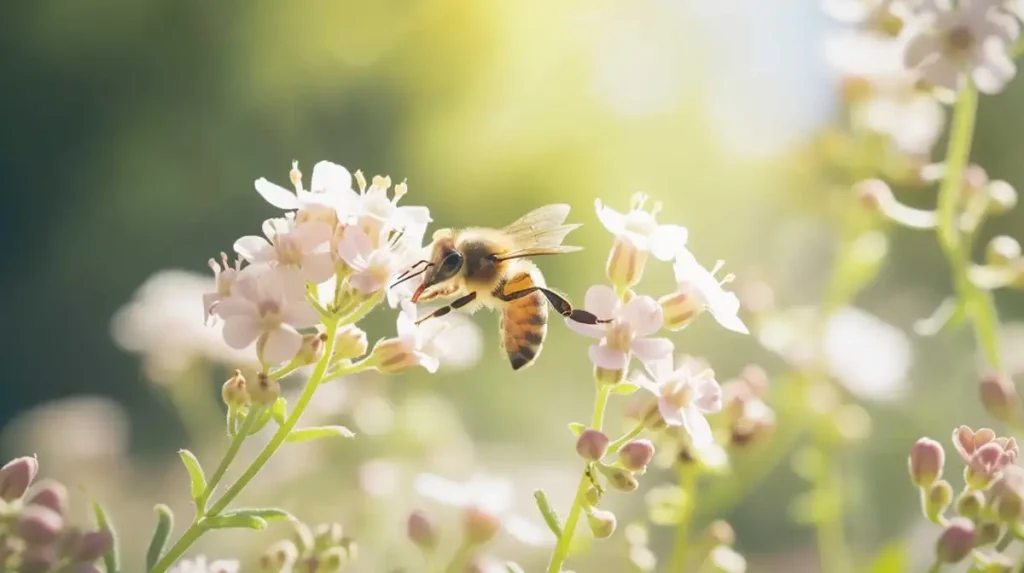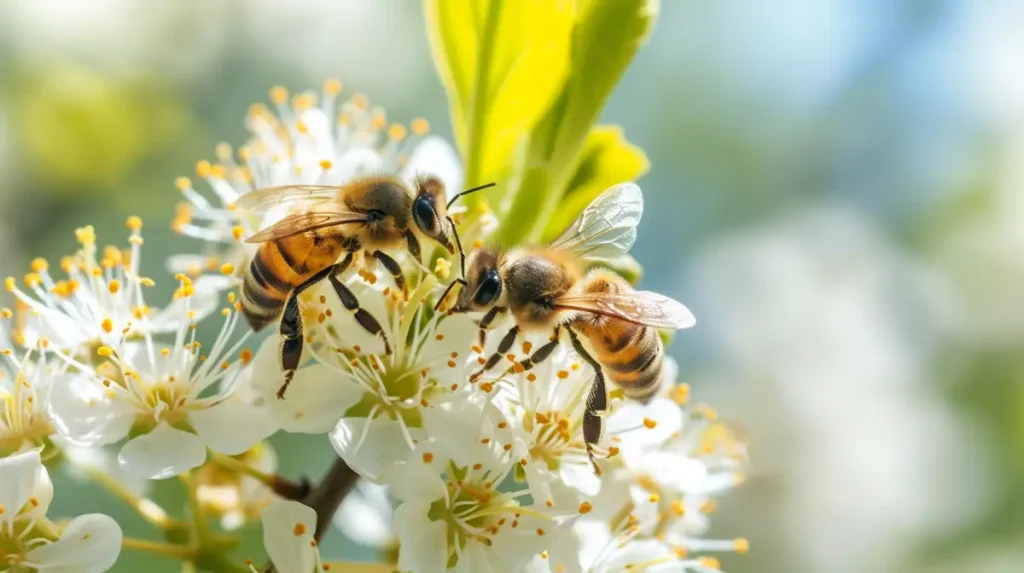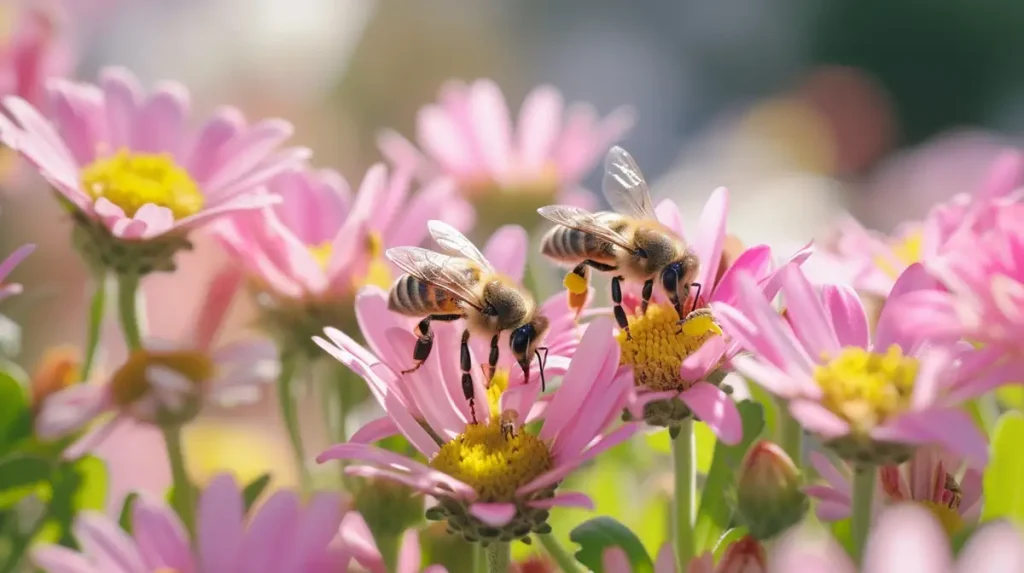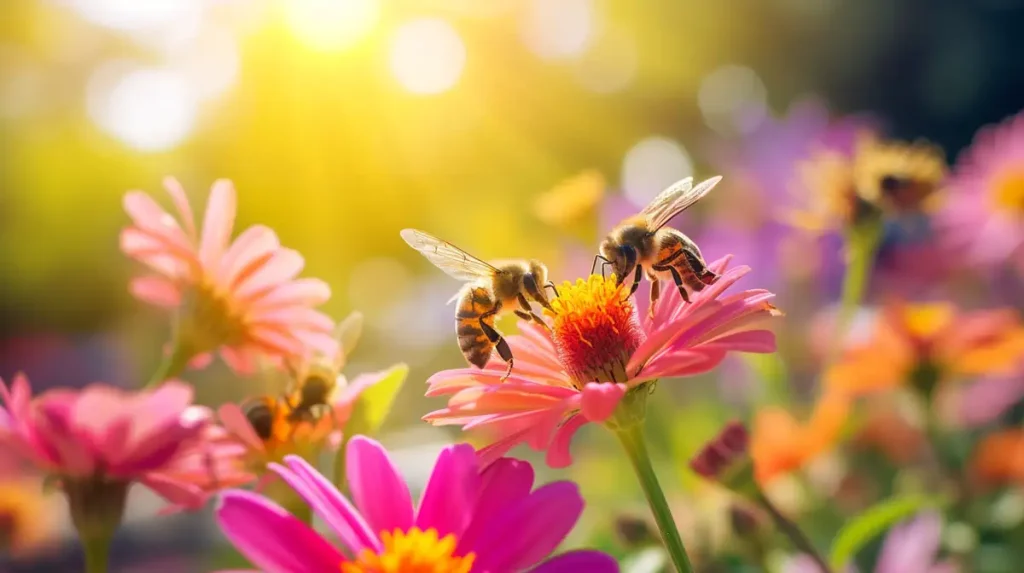Table of Contents
Bees and flowers have a special relationship that is critical to the health of our planet. These insects are responsible for pollinating a substantial portion of the world’s crops. Without them, we would not be able to grow the fruits and vegetables that we rely on. However, bee populations have been declining in recent years and it is important that we take action to support them. One way we can do this is by planting different types of flowers that bees love, including early spring and late summer flowers. In this article, I will explore the benefits of planting these flowers for bees as well as why they are so important to the health of our planet.
Key Takeaways
- Bees play a crucial role in pollinating one-third of the world’s crops, with an economic value of around $235 billion per year.
- Bee populations have been declining, and planting flowers can support their health and increase their numbers.
- Planting a variety of flowers with different bloom times, colors, and sizes can provide bees with diverse sources of nectar and pollen, promoting pollination, bee population growth, and ecosystem balance.
- Early spring flowers, like crocuses, daffodils, snowdrops, and hellebores, are essential for providing bees with food after winter.
- Late summer flowers, such as asters, sedum, goldenrod, and sunflowers, help bees prepare for winter by offering them high-nectar content.
- Choose flowers that thrive in your region and climate to support local bee populations effectively.
- Planting pesticide-free flowers and providing water sources for bees can further support their health and survival.
- Bees and flowers have a mutualistic relationship, with both benefiting from their interaction.
- Flowers are important for pollination, supporting pollinator populations, and their aesthetic and cultural value.
- Bees rely on stored honey and pollen when flowers are not available, making it essential to plant a variety of flowers with different bloom times.
The Benefits of Planting Flowers for Bees
Bees need flowers to survive as they rely on the nectar and pollen that they collect from them for food. Nectar is a sugary liquid that flowers produce to attract bees and other pollinators, and it is an essential source of energy for bees. Pollen, on the other hand, is a powdery substance that flowers produce and which is rich in protein and other nutrients that bees need to grow and reproduce.
When bees visit flowers to collect nectar and pollen, they inadvertently transfer pollen from one flower to another. This is how plants reproduce. This process of pollination is critical to the growth of countless crops as it helps to ensure that the plants produce fruit and seeds.
- Bees pollinate about one-third of the world’s crops, including fruits, vegetables, nuts, and seeds.
- The economic value of bee pollination to global agriculture is estimated to be around $235 billion per year.
- The number of managed honeybee colonies in the United States has declined by more than 40% since the 1940s.
- Planting flowers can help increase the number of bees in an area and support the health of bee populations.
Here is a table outlining the benefits of planting flowers for bees:
| Benefit | Description | Examples of Flowers |
|---|---|---|
| Enhanced Pollination | Planting flowers attracts bees, which are key pollinators for many crops and wild plants, improving fruit and seed production. | Lavender, Sunflowers, Borage |
| Biodiversity Support | A variety of flowers supports a diversity of bee species and other pollinators, contributing to a balanced ecosystem. | Wildflowers, Native plants, Clover |
| Garden Health | Bees help increase the health and yield of garden and agricultural plants through effective pollination. | Foxgloves, Calendula, Zinnias |
| Environmental Conservation | Supporting bees aids in the conservation of threatened bee populations, crucial for environmental health and biodiversity. | Echinacea, Bee balm, Butterfly bush |
| Educational Opportunities | Gardens with diverse flowers can serve as educational tools for learning about bees, pollination, and the importance of biodiversity. | Cosmos, Alyssum, Snapdragon |
| Aesthetic and Recreational Value | Flowering plants that attract bees also enhance the beauty of landscapes, offering recreational and therapeutic benefits to people. | Roses, Daisies, Poppies |
| Economic Benefits | Bees contribute to the success of agriculture and horticulture industries, vital for food production and economic health. | Fruit tree blossoms, Berry bushes, Squash flowers |
| Sustainable Gardening | Planting flowers for bees promotes sustainable gardening practices by reducing the need for chemical pesticides and fertilizers. | Herbs (e.g., Thyme, Basil), Marigolds, Nasturtium |
| Soil Health Improvement | Some bee-attracting plants are beneficial for soil health, either through nitrogen fixation or by acting as cover crops. | Peas, Clover, Vetch |
| Climate Resilience | Diverse plantings, including flowers for bees, can contribute to ecosystem resilience against climate change impacts. | Native wildflowers, Heat-tolerant flowers, Drought-resistant varieties |
Planting flowers beneficial to bees is a multifaceted approach that not only aids in bee conservation but also enriches our environment, supports agriculture, enhances biodiversity, and offers educational and aesthetic value.
The Importance of Planting Early Spring Flowers for Bees
Early spring flowers are especially important for bees as these are the first flowers to bloom after the winter months. At this time of year, bees are emerging from their hives and are in need of food to replenish their energy stores. By planting early spring flowers, we can help provide bees with the nutrition they need to survive and reproduce.
- Bees are among the first pollinators to emerge in the spring, and they need food sources as soon as possible to support the growth of their colonies.
- Early spring flowers are often the first sources of nectar and pollen for bees after the winter months.
- Crocuses are a popular early spring flower for bees, and they provide nectar and pollen as early as February in some regions.
Here’s a detailed table of some early spring flowers that are beneficial for bees.
It includes information on their common names, scientific names, bloom periods, color, and benefits to bees:
| Common Name | Scientific Name | Bloom Period | Flower Color | Benefits to Bees |
|---|---|---|---|---|
| Crocus | Crocus spp. | Early Spring | Various | Early nectar and pollen source |
| Snowdrop | Galanthus nivalis | Late Winter – Early Spring | White | Early nectar and pollen source |
| Winter Aconite | Eranthis hyemalis | Late Winter – Early Spring | Yellow | Early nectar source |
| Pussy Willow | Salix discolor | Early Spring | Yellow, Silver | Pollen source, attracts early foraging bees |
| Hellebore | Helleborus spp. | Winter – Early Spring | Various | Early pollen and nectar source |
| Heather | Calluna vulgaris | Early Spring | Pink, White, Purple | Nectar and pollen source, provides shelter |
| Primrose | Primula spp. | Early Spring | Various | Nectar source, attracts a variety of bees |
| Lungwort | Pulmonaria spp. | Early Spring | Blue, Pink, Purple | Nectar and pollen source, attracts bumblebees |
| Mahonia | Mahonia spp. | Winter – Early Spring | Yellow | Nectar and pollen source, good for early bees |
| Forsythia | Forsythia spp. | Early Spring | Yellow | Pollen source, bright and attractive to bees |
| Violets | Viola spp. | Early Spring | Various | Nectar and pollen source, supports native bees |
| Willow | Salix spp. | Early Spring | Yellow, Green | Crucial early pollen source for bees |
| Dandelion | Taraxacum officinale | Early Spring | Yellow | Rich in pollen and nectar, highly beneficial |
| Grape Hyacinth | Muscari spp. | Early Spring | Blue, Purple | Nectar source, attracts bees with its scent |
| Cherry Blossom | Prunus spp. | Early Spring | Pink, White | Nectar and pollen source, attracts many bees |
These early spring flowers play a crucial role in providing bees with necessary nutrients after winter, helping to kickstart the season for these essential pollinators. Planting a variety of these flowers can support bee populations by ensuring continuous bloom and food sources during early spring.

The Importance of Planting Late Summer Flowers for Bees
Late summer flowers are also important for bees, as they provide them with the nutrition required to prepare for winter. During the late summer months, bees are busy collecting nectar and pollen to store in their hives for the winter months, at which time food is obviously scarce.
- Late summer flowers provide bees with the nutrition they need to prepare for winter.
- Bees use nectar and pollen from late summer flowers to build up their food stores for the winter months.
- Sunflowers are a popular late summer flower for bees, and they can produce up to 1,000 florets, each of which contains nectar and pollen.
Here is a detailed table of late summer flowers beneficial for bees.
It covers various aspects such as flower name, bloom time, color, type (annual/perennial), and additional notes that are helpful for bees and gardeners:
| Flower Name | Bloom Time | Color | Type | Additional Notes |
|---|---|---|---|---|
| Goldenrod (Solidago) | Late summer to fall | Yellow | Perennial | A major nectar source for bees, attracts a wide variety of pollinators. |
| Aster | Late summer to fall | Purple, blue, white | Perennial | Provides late-season nectar and pollen, supports a diverse range of bees. |
| Sunflower (Helianthus) | Summer to early fall | Yellow | Annual/Perennial | Easy to grow, highly attractive to bees, provides both nectar and pollen. |
| Joe-Pye Weed (Eutrochium) | Late summer to fall | Pink, purple | Perennial | Tall, striking plants that attract bees and butterflies with their nectar. |
| Sedum (Stonecrop) | Late summer to fall | Pink, red, yellow | Perennial | Succulent leaves, drought-resistant, flowers provide nectar for bees. |
| Hyssop (Agastache) | Summer to fall | Purple, pink, orange | Perennial | Aromatic leaves, flowers rich in nectar, attracts bees and butterflies. |
| Coneflower (Echinacea) | Summer to early fall | Pink, purple, white | Perennial | Drought-tolerant, provides nectar and later seeds for birds. |
| Cosmos | Summer to fall | Various | Annual | Easy to grow, blooms until frost, attracts a variety of bees and butterflies. |
| Zinnia | Summer to frost | Various | Annual | Long blooming period, provides vibrant color and nectar sources. |
| Anise Hyssop (Agastache foeniculum) | Summer to fall | Purple | Perennial | Licorice-scented flowers, a magnet for bees and butterflies. |
These plants not only offer vital resources to bees during the late summer months when other food sources may be diminishing but also add vibrant colors and textures to the garden. Planting a variety of these flowers can help ensure that bees have access to continuous blooms for foraging.
Choosing the Right Flowers for Your Area
When choosing flowers to plant for bees, it is important to consider the specific region and climate in which you live. Different types of flowers thrive in different conditions, so it is important to choose flowers that will grow well in the area in which you live.
Some of the factors to consider when choosing flowers for bees include bloom time, color, and size. Bees are attracted to flowers that are brightly colored, especially shades of blue, purple, and yellow. They are also attracted to flowers that are large and have a lot of nectar and pollen.
- Carter, Anthony (Author)
- English (Publication Language)
- 194 Pages - 02/28/2024 (Publication Date) - Independently published (Publisher)
- Different types of flowers thrive in different conditions, so it’s important to choose flowers that will grow well in your region.
- Native flowers are often the best choice for supporting local bee populations, as they have evolved to grow in your specific climate and soil conditions.
- When choosing flowers, it is important to consider the bloom time, color, and size of the flowers to ensure that they are attractive to bees.

Tips for Planting Flowers for Bees
When planting flowers for bees, it is important to use organic and pesticide-free seeds and soil. Pesticides can be harmful to bees and they can reduce the number of bees that visit your garden.
It is also important to plant a variety of flowers that bloom at different times of the year so that bees have a continuous source of food throughout the growing season. Finally, it is crucial to maintain your bee-friendly garden over time by watering and fertilizing your flowers as needed and removing any dead or diseased plants that may attract pests.
- Plant a variety of flowers that bloom at different times of the year to provide bees with a continuous source of food.
- Avoid using pesticides and herbicides, as these chemicals can be harmful to bees and other pollinators.
- Provide a source of water for bees, such as a shallow dish with rocks, as bees need water to survive.
Here is a detailed table with tips for planting flowers to attract and benefit bees.
This guide aims to provide an effective strategy for creating a bee-friendly garden.
| Category | Tip | Details |
|---|---|---|
| Flower Variety | Plant a diverse selection of flowers | Include flowers of different colors, shapes, and sizes to attract a wide variety of bees. Variety ensures a continuous bloom cycle throughout the seasons, providing consistent food sources. |
| Native Plants | Prioritize native plants | Native plants are more likely to thrive in your area and are usually more beneficial to local bee populations. They require less maintenance and are adapted to the local climate and soil. |
| Bloom Time | Ensure continuous bloom | Plan your garden so that you have plants blooming from early spring to late fall. This strategy provides bees with a consistent source of nectar and pollen. |
| Avoid Hybrids | Choose single-petal flowers over doubles | Double flowers are often bred for looks and may lack nectar and pollen, or be difficult for bees to access. Single-petal flowers usually offer more nectar and pollen and are easier for bees to pollinate. |
| Color Preference | Focus on blue, purple, white, and yellow flowers | Bees are particularly attracted to these colors. Planting flowers in clumps rather than singly can help bees find them more easily. |
| No to Pesticides | Avoid using pesticides in your garden | Pesticides can harm or kill bees. If you must use them, choose organic options and apply them at night when bees are less active. |
| Planting Strategy | Use companion planting | Planting certain flowers together can help deter pests naturally without the need for chemicals. For example, marigolds can repel certain nematodes and might benefit neighboring plants by providing a protective barrier. |
| Water Sources | Provide water for bees | Bees need water to drink and to regulate the temperature of their hive. A shallow water source with landing spots, such as pebbles or twigs, allows bees to hydrate safely without drowning. |
| Shelter | Leave some natural habitat | Leaving areas of your garden a little wild can provide nesting sites for bees. Bare patches of ground, dead wood, and undisturbed grassy areas can offer suitable nesting sites for ground-nesting and wood-nesting bees, respectively. |
| Sunlight | Plant in sunny areas | Most bee-attractant flowers require full sun to thrive and produce the maximum amount of nectar and pollen. Additionally, bees are more active in sunny areas, making these spots ideal for foraging. |
| Organic Mulch | Use organic mulch sparingly around bee-preferred plants | While mulch helps retain soil moisture and suppress weeds, too much can deter ground-nesting bees. Use organic mulch sparingly and consider leaving some ground bare or lightly covered for bees to access. |
| Maintenance | Deadhead flowers regularly | Removing spent flowers encourages plants to produce more blooms, extending the flowering season and providing more resources for bees. |
| Education and Sharing | Educate your community and encourage others to plant bee-friendly gardens | Sharing knowledge and resources about bee-friendly gardening practices can amplify the positive impact on bee populations. Consider participating in or organizing community garden projects focused on supporting bees and other pollinators. |
By following these tips and considering the needs of bees in your garden planning, you can create a vibrant, bee-friendly environment that supports these crucial pollinators throughout the year.
Bees and Flowers Mutualism
Bees and flowers exemplify one of nature’s most enchanting mutualistic relationships, where both parties derive significant benefits from their interaction. This symbiosis is a cornerstone of ecosystems, agriculture, and the global food supply. Bees, as pollinators, play a crucial role in the reproductive cycle of flowers. When bees search for nectar and pollen to feed themselves and their larvae, they inadvertently transfer pollen from the male parts of one flower to the female parts of another, facilitating fertilization. This process results in the production of seeds and fruits, ensuring the continuation of plant species and contributing to the diversity and resilience of ecosystems.
In return, flowers offer bees essential nutrients through their nectar and pollen. Nectar provides bees with carbohydrates, which supply energy for their flight and daily activities, while pollen offers proteins and fats necessary for their growth and development. The evolution of flowers has been significantly influenced by their relationship with bees, leading to the development of various colors, scents, and shapes that specifically attract bees, ensuring effective pollination. This mutualistic relationship highlights the intricate interdependencies within ecosystems and underscores the importance of conserving both bees and flowering plants to maintain ecological balance and biodiversity.

Flowers that Help Bees
- Sunflowers are a great source of nectar and pollen for bees, and they bloom from mid-summer to early fall.
- Lavender is an attractive flower for bees, and it provides nectar from early summer to early fall.
- Wildflowers are an excellent choice for supporting local bee populations as they are often native to the region and provide a variety of nectar and pollen sources.
Here is a table that provides detailed information on various flowers known for their high nectar content.
These flowers not only offer vital nutrients but also play a crucial role in the bees’ foraging activities, contributing significantly to their health and the pollination process.
| Flower Name | Bloom Period | Nectar Concentration (% weight/weight) | Location Preference | Bee Attraction Level | Additional Notes |
|---|---|---|---|---|---|
| Lavender (Lavandula spp.) | Summer | 30-50% | Full sun, well-drained soil | High | Lavender’s scent and color are highly attractive to bees, especially bumblebees and honeybees. |
| Borage (Borago officinalis) | Late Spring to Summer | 35-44% | Full sun to partial shade, well-drained soil | Very High | Borage replenishes its nectar every few minutes, making it a consistent food source. |
| Sage (Salvia spp.) | Late Spring to Summer | 25-30% | Full sun, well-drained soil | High | Sage flowers are popular among a variety of bees, including honeybees and native bees. |
| Clover (Trifolium spp.) | Spring to Early Fall | 32-40% | Full sun to partial shade, tolerates various soil types | Very High | Clover is a key nectar source for honeybees, contributing to high-quality honey. |
| Fireweed (Chamerion angustifolium) | Summer | 30-50% | Full sun to partial shade, moist soil | High | Fireweed is especially beneficial for rebuilding bee populations in areas affected by fire. |
| Echinacea (Echinacea spp.) | Summer to Early Fall | 25-35% | Full sun, well-drained soil | High | Echinacea, or coneflower, attracts bees with its large, daisy-like flowers. |
| Sunflower (Helianthus annuus) | Summer | 20-25% | Full sun, well-drained soil | High | Sunflowers are not only attractive to bees but also provide seeds for birds in the fall. |
| Buckwheat (Fagopyrum esculentum) | Summer to Early Fall | 40-50% | Full sun, well-drained soil | Very High | Buckwheat flowers produce nectar that is rich in nutrients and can improve soil health. |
| Catmint (Nepeta spp.) | Spring to Fall | 20-30% | Full sun to partial shade, well-drained soil | High | Catmint offers a long blooming period, providing a consistent nectar source. |
| Foxglove (Digitalis spp.) | Early Summer | 25-30% | Partial shade, moist soil | Moderate | Foxglove attracts long-tongued bees such as bumblebees, which can access the tubular flowers. |
Note: The nectar concentration values are approximate and can vary based on environmental factors and specific species within a genus. Additionally, while these flowers are beneficial to bees, it’s important to consider the entire ecosystem and plant a variety of flowers to support a wide range of pollinators.
What Do Bees Eat When There Are No Flowers?
When there are no flowers available, bees will rely on stored honey and pollen that they have collected earlier in the year. If there is not enough stored food to sustain the hive, the bees may begin to starve. This is why it is important to plant a variety of flowers that bloom at different times of the year. Doing so means that bees have a continuous source of food throughout the growing season.
Bees and Flowers – Conclusion
In conclusion, planting different types of flowers for bees is an important way to support bee populations and to promote the health of our planet. By providing bees with the nutrition that they need to survive and reproduce, we can help to ensure that they continue to play a critical role in pollination. Whether you plant early spring flowers, late summer flowers, or a variety of flowers that bloom throughout the growing season, you can make a difference in the lives of bees and in the health of our planet.
Last update on 2024-04-17 / Affiliate links / Images from Amazon Product Advertising API


